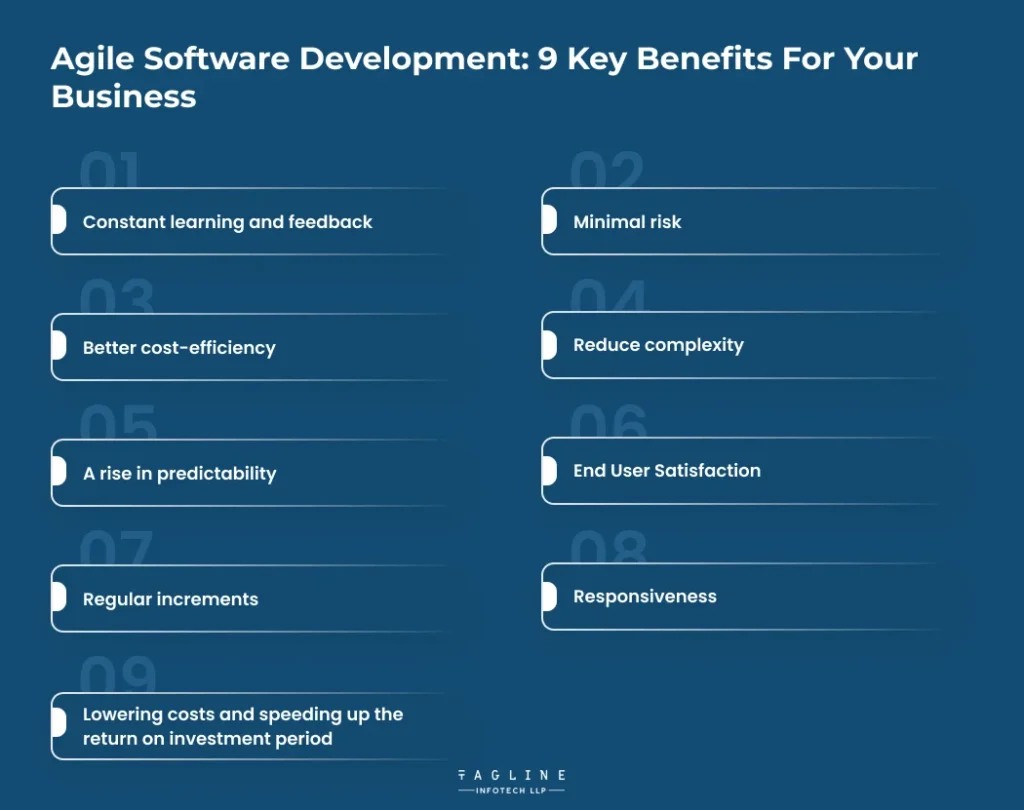Role of Python Libraries in Image Processing
October 30, 2025
Home >> Software >> Top 9 Great Business Benefits of Agile Software Development

Quick Summary
The agile method emphasizes adaptability, changeability, and responsiveness in Agile Software Development. To follow agile principles, the project must be flexible, changes to the product should be made only when necessary, and stakeholder feedback should be sought frequently.
The agile methodology, a modern approach to software development, prioritizes iterative and adaptable development. Self-organized and cross-functional teams cooperate at every project stage to break the process into smaller parts and work together on user-centered software systems during each phase.
The primary aim of the Agile methodology is to expedite the delivery of a functional product to the market by integrating user feedback throughout the software development life cycle. One of the key Agile methodology advantages is that it allows for continuous improvement and adaptation, enabling developers to respond quickly to changing requirements. Consequently, by delivering a final product that passes the quality check and closely matches the user stories, developers can ensure that businesses get exactly what they need.
Agile software development is all about getting your product in front of customers as quickly and often as possible. As a result, clients receive the most value possible, and the time to market is shortened.
Development teams can do this by working in shorter, more focused cycles known as sprints or iterations. Throughout these stages, they collaborate closely with clients and other interested parties to gather crucial data about the problem they are trying to address.
Adhering to established protocols that guarantee quality at every turn is key to maintaining this rapid pace error-free. This shows that you can deliver your work at any time throughout or in between these short cycles without interfering with the workflow.

In the context of organizations, the main benefits of agile software development are quantifiable and immediately apparent. This category includes better code quality, fewer integration and deployment conflicts, higher developer efficiency, and adaptive planning.
Client satisfaction and the project stage play pivotal roles in achieving success in agile software development. Exceeding expectations remains crucial, even when reaching milestones. Regular sprint reviews facilitate incremental reporting, enabling stakeholders to approve new features based on progress. Explore the benefits of agile methodology and agile development below.
Considering hiring a dedicated software development team following the Agile framework? Explore the assured benefits awaiting you:
When teams and businesses under the agile methodology constantly interact, everyone may learn from one another. With constant feedback loops, we can promptly address any mistakes and adjust the strategy based on our input. Without a doubt, this approach benefits from continual delivery.
Teams that benefit from this can potentially be more productive, less likely to produce subpar deliverables, and often able to provide more excellent value within budget and on schedule. Agile teams are known for their quick learning and adaptation and consider management feedback as they go.
Agile processes increase productivity while lowering risk; the methods reduce errors; customers are satisfied by continuous deployment; interested parties are kept happy by regular and early releases of public versions; and sustainable development produces sustainable ecosystems.
But, waterfall software development carries a lot greater risk because it is tough to amend or cancel after you commit to a phase. User input is crucial in determining whether or not new features should be released in agile software development.
Agile software development strongly emphasizes frequent and early delivery of the finished product. This allows users to continuously submit feedback, allowing issues to be fixed as they arise. When waterfall projects are completed, a substantial amount of work is conducted before receiving customer feedback. Because of this, a great deal of work needs to be changed to satisfy the client’s needs.
Agile is the optimal software development approach, addressing the unpredictable nature of customers and business goals. It provides a competitive edge by swiftly adapting to changing client demands. Quality assurance work is more cost-effective, as Agile allows quick adjustments based on feedback, preventing later-stage issues.
Agile project management techniques, intended to be more flexible and dynamic than traditional project management approaches, allow changes to be made along the way without resulting in extra costs or time. Therefore, the fact that changes will only be needed when necessary rather than at every stage of development may produce high-quality deliverables.
Among the many benefits of agile development is its ability to reduce the complexity of the software development life cycle. Only some things that have to be written need to be developed, tested, and maintained by the core programming team simultaneously. Instead, smaller teams work iteratively on different parts of the project concurrently, finishing one team’s work before handing it off to another (or returning to address any issues found).
As a result, people are allowed to learn without experiencing a great deal of worry and are even encouraged to make mistakes while doing so. Furthermore, it inspires entrepreneurs, developers, and product owners to embrace change instead of being frightened that they won’t be able to please everyone. Finally, it explains more precisely what you get for the money and effort you devote to the product backlog.
Agile software development’s iterative approach increases the likelihood that projects will be finished on schedule, under budget, and with a higher-quality product than they would have been without it. This is because features are not implemented blindly by multiple programmers at different periods linearly from the start but are prototyped and tested throughout the unified process.
Because of this, the feedback loop is kept tightly closed, preventing scope creep or major modifications during the creation of an item. One of the key advantages of agile development methodology is the promotion of responsibility, as it inspires team members to focus more intently on every little detail.
Customer satisfaction is third on our list of advantages linked to the Agile approach, as the Agile methodology constantly emphasizes giving value to a product’s end consumers.
User stories are casual, naturally curated summaries of software needs specifications that are simple for humans to understand. Creating user stories from features is an exciting way to achieve this. One type of storytelling is through user stories. These tales are the standards a feature or product must meet to be accepted by end consumers.
If your software development company adopts an agile approach, it can provide smaller, more frequent increments. Doing this will give you early feedback on how customers interact with your product. Customers will notice it more readily when they are happy or dissatisfied with anything, and their satisfaction will also contribute positively to your bottom-line profits.
This reduces the number of problems that often crop up at the end of a project (like mobile applications) when there is little time left to fix them because everything has been finished and launched.
Agile software development is an excellent substitute for the traditional approach to product development because of this. Agile development over traditional methods with numerous advantages.
The agile paradigm guarantees that you can continue to develop your product with minimal additional costs or resources for different versions and that you can make ongoing enhancements without redoing substantial portions of work. This is achieved by gradually iterating through minor adjustments.
Agility is a critical component of agile methodologies, allowing organizations to react more quickly to the constantly shifting needs of their clients. This responsiveness is vital when considering the state of agile product development today. Businesses that can quickly adjust to agile products will be better positioned to seize opportunities presented by these products and gain an advantage over less nimble competitors. Agile approaches have customer collaboration as one of their core tenets.
Agile application development is more economical than traditional process development since agile project managers can produce projects with fewer resources. Agile product management teams can create more effective products that meet their end users’ needs throughout the development process.
Pair programming is another approach that offers room for improvement because it only requires one coder at a time. Pair programming reduces the likelihood of errors by eliminating human forgetfulness or loss of focus when coding under intense pressure from deadlines imposed by supervisors or clients.
Agile software development offers distinct advantages over traditional methods, providing quicker ROI and lower costs. The Agile methodology ensures greater control over the products you receive by empowering the organization to maintain control throughout the development process, resulting in shorter delivery dates. Connect with Our Software Development Team to leverage these benefits for your projects.
Improved quality is considered one of the biggest advantages of using agile software development. Its iterative approach focuses on constant improvement which helps to create best-in-class products.
There are some popular project management tools like Jira, Lean Kit, Active Collab, and many more that follow all the principles of agile methodology.

Digital Valley, 423, Apple Square, beside Lajamni Chowk, Mota Varachha, Surat, Gujarat 394101
D-401, titanium city center, 100 feet anand nagar road, Ahmedabad-380015
+91 9913 808 2851133 Sampley Ln Leander, Texas, 78641
52 Godalming Avenue, wallington, London - SM6 8NW